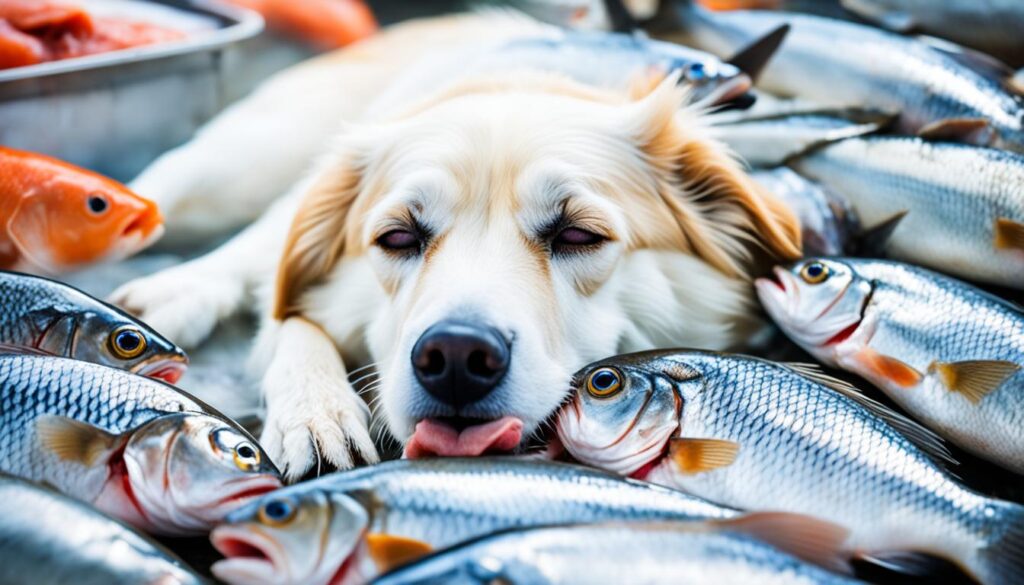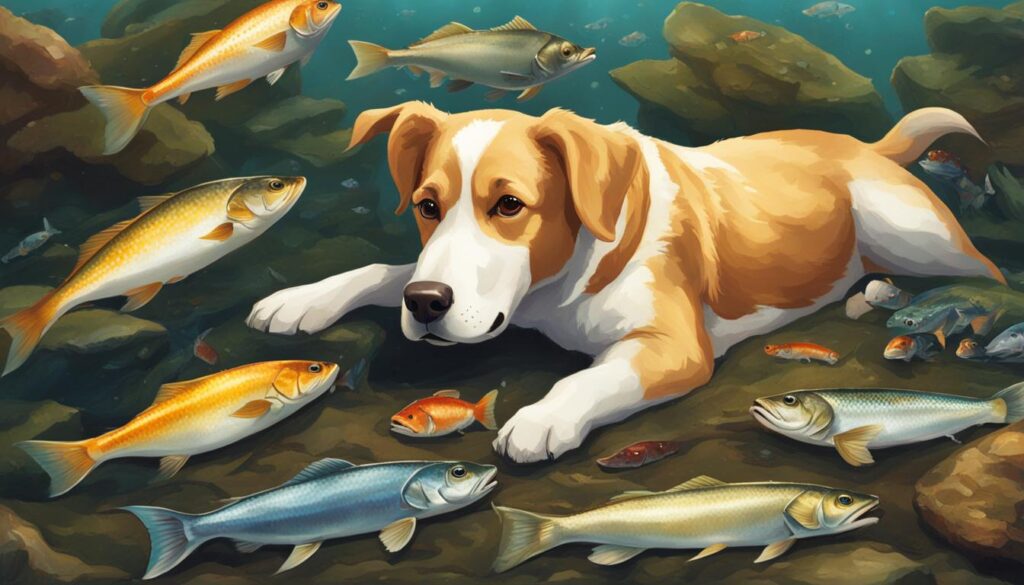As an Amazon Associate I earn from qualifying purchases.
Picture this: a serene Sunday morning, the sun peering just enough through your window to highlight the whimsical dance of dust motes in the air. In this peaceful tableau, you might find yourself leisurely flipping pancakes while your loyal canine companion sits patiently nearby, eyes glistening with anticipation, sniffing the air for any hint of breakfast. But beyond the sizzle of your griddle, have you ever wondered what tickles your furry friend’s taste buds? Does that glisten in their eyes speak of a hidden desire for…fish?
In their hearts and stomachs, dogs have more in common with their wild ancestors than just howling at the moon. The debate over canine diet, dogs preferences, and the penchant for fish-eating dogs turns the table on what we consider normal for our pet pals. According to the American Kennel Club, our four-legged friends can indeed enjoy the occasional aquatic entrée as part of a balanced diet, opening up a sea of culinary possibilities. Let’s make a splash into the diet de la mer and see if our dogs are ready to dive in!
Key Takeaways
- Based on the American Kennel Club, fish can be a delightful addition to a dog’s balanced diet.
- Commercial dog foods frequently feature fish as a protein staple, hinting at its safety and popularity.
- Veterinary nutritionists advocate fish for its protein content while emphasizing moderation.
- It is essential to introduce new meals like fish into your pup’s diet cautiously.
- Pet care experts from the ASPCA suggest keeping a watchful eye on how your dog responds to their first nautical nosh.
Exploring Canine Palate: Are Dogs into Seafood?
It’s not just cats who purr at the sight of a fish; our canine friends too may harbor a secret love affair with the fruits of the ocean. Groundbreaking research highlighting the evolution of canine taste receptors suggests that dogs might have inherited more from their ancestors than just their looks. Indeed, the study finds parallels between the taste preferences of dogs and wolves, their forebears, with a strong leaning toward protein-rich diets that readily include fish.
What’s been making a splash in the realm of canine nutrition is the steady rise in seafood-based dog food products. Pet dietary trends have visibly shifted, welcoming an array of fish-infused creations that promise not just flavor but a boatload of health benefits. Pet food aisles now boast a veritable smorgasbord of options, from salmon to cod, anchoring a robust market for dogs and seafood.
And the reaction? The enthusiasm is tail-wagging! Canine behavior specialists have long observed Fido’s fervent approach to fish-flavored treats, a strong testament to the paw-sitive reception of seafood among the dog population.
“It’s a resounding yes from the canines when it comes to seafood, and it shows not just in their happy dances but in their overall health,”
notes one such expert.
We must consider, however, that while dogs might dive fin-first into the fishy waters of their feeding bowls, moderation and supervision are key. Incorporating fish into a dog’s diet is not without its nuances and should be done with an understanding of the bigger picture of canine nutrition.
- A study on canine taste receptors indicates a preference for meats, including fish.
- Pet dietary patterns show an increasing trend towards seafood-based options.
- Behavior specialists note dogs’ excitement toward fish-flavored treats.
As we navigate this seafood saga, we must ensure that our beloved pups receive a balanced diet that not just satisfies their taste buds but also supports their overall health and well-being.
The Nutritional Benefits of Fish in a Dog’s Diet
When considering canine nutrition, incorporating fish into your furry friend’s menu could reel in some impressive health benefits. Not only is it a high-quality protein source for dogs, but it’s also rich with nutrients that support their overall well-being. Let’s dive into the sea of benefits that fish can offer to our canine companions.
Omega-3 Fatty Acids and Canine Health
Omega-3 fatty acids, specifically EPA and DHA, are the shining stars of the fish nutrient galaxy. These essential fats are known to enhance a dog’s cognitive function, making Fido’s brain as sharp as a shark’s tooth. Additionally, they contribute to lustrous fur, reducing the chances that your dog’s coat will ever look fishy. And let’s not forget about joints; Omega-3s help keep them as smooth as a salmon gliding through the stream.
High-Quality Protein Source for Dogs
The biological value of fish protein is off the scales! With all the essential amino acids packed into a single bite, it’s no wonder that it’s considered a high-quality protein source for dogs. Each morsel is a treasure trove for muscle maintenance and repair, ensuring your pup’s tail-wagging is powered by premium protein.
Vitamins and Minerals Found in Fish
Swimming right up to the top of the nutrient food chain, fish is loaded with vitamins and minerals essential for a dog’s health. Vitamin D, the sunshine vitamin, is naturally abundant in fish, fortifying bones and keeping smiles wide. Phosphorus, also found in ample supply, works in tandem with calcium to keep your canine’s framework firm and sturdy. Let’s take a closer look at the nutrient profile of common fish in a dog’s diet:
| Fish Type | Vitamin D Content | Phosphorus Content | Omega-3 Fatty Acids |
|---|---|---|---|
| Salmon | 14.5 µg/100g | 200 mg/100g | 2.260 mg/100g |
| Mackerel | 10 µg/100g | 214 mg/100g | 2.670 mg/100g |
| Herring | 22 µg/100g | 236 mg/100g | 1.885 mg/100g |
In summary, the role of fish in a dog’s diet cannot be underestimated. From the depths of the ocean to the tip of your dog’s tongue, fish brings a boatload of nutrients that promote a thriving, healthy life for our four-legged sea-faring companions.

Do Dog like eating fish?
When it comes to K-9 culinary preferences, the debate of whether dogs savor the taste of fish has been ongoing. Are these furry friends fans of underwater fare, or do they prefer to keep their paws dry when it comes to their palates? Let’s dive into the sea of information available and net us some answers.
Recent canine preference tests have cast a spotlight on the topic, uncovering that many pups do indeed have a penchant for piscine pleasures. The array of fish flavors, from the robust salmon to the milder tilapia, seems to entice their taste buds in quite a spectacular fashion. In these trials, fish often floated to the top as a favorite, even when lined up against other protein strongholds.
Dog owners from across the board—whether they’re from bustling cities or bucolic countrysides—swell the internet forums with praises of how their pets lap up fish dishes. If we were to compile a ‘Yappy Hour’ menu, fish would likely be a recurring special based on these glowing testimonials. But, what’s even better, you ask? The virtuous circle formed by the fact that integrating fish into their diets doesn’t just satisfy their taste branches, but also nourishes their furry bodies.

While science and social proof have tipped the scales towards a positive answer to the question “do dogs like eating fish?”, it’s not just about packing their bowls with the fruits of the sea at every turn. Feeding fish to dogs should be approached as one might approach seasoning a dish—with balance and thought for the overall recipe, which, in this case, is their diet.
For those tail-wagging connoisseurs out there, it seems clear as fishbowl water that we’re barking up the right tree—or, should we say, swimming in the right school—when we consider the addition of fish to their meals. Just remember, moderation is key, and keeping their health in check is the real treat!
Safe Ways to Serve Fish to Your Furry Friend
Dishing out seafood for your four-legged companion doesn’t have to be a high-seas adventure fraught with peril. A few simple tips can help turn the treacherous tides of feeding fish to dogs into smooth sailing. Let’s dive in and explore how to keep your pooch’s tail wagging safely at mealtime.
Properly Cooking Fish for Canine Consumption
A well-cooked fish dish could rival a belly rub for some dogs, and it certainly ups the health quotient. Veterinary advice is clear: it’s paramount to cook fish thoroughly to kill any unfriendly stowaways like parasites and bacteria. Not all fish are equal in the eyes of our canine chefs, though. When it comes to cooking the fish for dogs, stick to steaming or baking, avoiding those fatty oils and mysterious spices.
Caution about Fish Bones and Dogs
While our furry friends might fancy themselves as wild wolves adept at tackling any kind of prey, domestic bliss hasn’t equipped them with the same fish bone navigation skills. Indeed, there’s a serious caution about fish bones when it comes to four-legged diners. The danger of choking or worse—internal blockages or tears—can turn a fish feast into a rapid voyage to the vet.
Pets and bones may seem like an old tale, but caution, not lore, should dictate your dog’s platter. — Prominent Pet Nutritionist
Here’s an easy-to-follow table highlighting how to prepare fish to avoid bone-related health scares:
| Fish Preparation: | Benefits: | Potential Risks: |
|---|---|---|
| Filleted and Deboned | Removes most hazardous bones | Possible small bones may remain |
| Ground Fish | Evenly distributes any tiny, softened bones | Quality control depends on the source |
| Whole Fish (specially prepared) | Provides mental stimulation and chew satisfaction | High risk of bone hazards without meticulous preparation |
So, garb your apron, unfurl your culinary flag, and with these guidelines at the helm, prepare to sail the sea of cooking fish for dogs. Your canine skipper will thank you for the safe voyages and tasty treasures!
When Fish Isn’t a Good Fit: Canine Allergies and Dietary Restrictions
Canine allergies can often manifest as a spaniel-sized wrench in well-laid dietary plans, particularly when it comes to incorporating fish as dog food. It’s not merely a matter of a picky palate; for some pups, fish can trigger significant allergic reactions, often characterized by skin irritations and tummy troubles that will have you running for the vet faster than a Greyhound chasing a rabbit.
Dogs, like their human companions, can have dietary restrictions that necessitate a careful examination of mealtime menus. For your furry friend, the fragrant aroma of a baked salmon might be less of a treat and more of a trip to Itchville. Veterinary studies specifically pinpoint fish as a notable allergen in dogs, with potential adverse effects ranging from fur furor to gastrointestinal gaiety-turned-gloomy.
Let’s not forget our canine companions with health concerns that call for a bespoke buffet. Certain conditions require tailored dietary plans, where fish might be the ‘finned fiend’, hovering on the ‘no-fly’ list of their doggy diet. Convincing these four-legged patients to turn their nose up at a tantalizing tuna can be as challenging as explaining quantum physics to a beagle.
“Making the right nutritional choices for your dog can have as much nuance as choosing the perfect chew toy — it needs to be appealing yet won’t cause an uproar in the digestive department.” – A Wise Dog Nutritionist
So, what’s a devoted dog parent to do when their pooch can’t partake in a pescatarian plate? Cue the entrance of alternative protein sources that can keep tails wagging without the watery woes. Canine nutritionists have dived deep into the abyss of Food Sea to salvage alternative treasures that may pass the sniff (and taste) test without setting off the allergy alarms.
Behold the table of alternatives for our fish-averse furry friends:
| Protein Source | Benefits | Considerations |
|---|---|---|
| Chicken | Lean and packed with essential amino acids | Common allergen, proceed with caution |
| Lamb | Normally a good option for dogs with allergies | Richer in fat, balance with a healthy diet |
| Beef | Highly palatable and widely available | Another potential allergen, keep an eye on any reactions |
| Plant-Based Proteins | A reasonable option for dogs with severe allergies | Needs careful planning to ensure adequate nutrient intake |
Well, that’s the scoop on soup (sans fish) for your pupper. Remember, every dog is an individual, with tastes and dietary needs as diverse as their human’s Netflix preferences. With wisdom and a watchful eye, your canine’s menu can be a smorgasbord of health, variety, and tail-wagging deliciousness, even without a single fish flake in sight.
Feeding Fish to Dogs: Questions to Ask Your Vet
When considering incorporating fish into your canine’s diet, it’s prudent to have a chat with your vet. This conversation ensures your pup’s health is paramount when you make waves in their diet. Here’s the catch of the day: questions you must ask to provide the best care for your furry friend.
Before your dog dives fin-first into a new seafood feast, catch these necessary snippets of advice:
- What portion size is appropriate for my dog’s breed, age, and weight?
- How frequently should I feed my dog fish without going overboard?
- Are there specific types of fish that are more suitable or beneficial for my dog’s unique health profile?
Personalized nutritional advice is vital, especially for those pups who might be navigating the rocky waters of chronic conditions or dietary sensitivities. Your vet is your co-captain here, steering you away from the rough seas of generic feeding plans and towards the calm waters of a tailored canine diet.
Remember, while feeding fish to dogs can be full of health benefits, it’s not a one-size-fits-all sea tale. Use this vet checklist to ensure a smooth sailing transition to a fishy (but in a good way) diet for your dog:
| Question | Purpose | Details |
|---|---|---|
| What fish are toxic or harmful to dogs? | To prevent potential health risks | Some fish species may contain toxins that are dangerous for dogs. |
| Does my dog have any existing conditions that fish could exacerbate? | To ensure fish complements my dog’s health | Fish can interact with certain health conditions, either beneficially or adversely. |
| Can fish replace one of my dog’s current protein sources? | To maintain a balanced diet | It is crucial to keep a pup’s diet varied and balanced with different protein sources. |
So there you have it, your treasure map to a scaly new addition to your pup’s menu. By consulting your vet, you’re not barking up the wrong tree—or should we say, swimming up the wrong stream?
Conclusion
The dive into the world of canine nutrition reveals an interesting tide – a notable number of fish-eating dogs thriving on diets that include everything from salmon to sardines. Culinary curiosity isn’t just a human trait; our four-legged friends also show a penchant for a variety of flavors, including those from the sea. However, the overarching theme we’ve unspooled throughout this article is clear as daylight: while fish can be a fantastic addition to a pooch’s diet, their individual needs and reactions should guide the menu.
Indeed, though many a wagging tail will hasten towards a bowl garnished with fish, it is imperative for pet parents to keep a vigilant eye on their dog’s reaction to this oceanic offering. When incorporating fish in a dog’s diet, it must land on their meal plan like a boat gently kissing the shore – carefully, and with consideration to avoid capsizing their wellbeing. Anchoring a pup’s diet requires a balance of nutrients, and fish should only be one of the vessels delivering these dietary essentials.
Before we draw the anchor up on this topic, remember that educating oneself on the facets of feeding dogs is not just about filling their bowls with something new but about navigating towards the shores of health and wellness. A chat with the vet can illuminate the best path forward. Charting a course for your dog’s dietary voyage with informed decisions will assure that the tidal waves of dietary changes break favorably, keeping their tails high and their health robust. Smart feeding choices contribute to happy, healthy, and high-spirited canine companions, swimming smoothly through their days.
FAQ
Do Dogs Enjoy Fish As Part Of Their Diet?
Are Canine Buddies Swayed By The Allure Of Seafood?
What Nutritional Magic Does Fish Perform In A Dog’s Diet?
When It Comes To Snack Time, Do Dogs Really Go Overboard For Fish?
How Should One Serve Up Fish To Their Canine With Care?
Are There Dogs That Might Have To Skip The Fish Fry?
What Fishy Questions Ought To Be Pitched To The Vet?
As an Amazon Associate I earn from qualifying purchases.


[…] Do Dogs Enjoy Fish? Canine Dietary Preferences Tail Wagging Hub […]